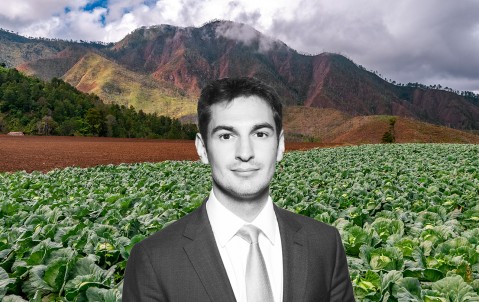Read the rest of the post ' Hiscox Re & ILS appoints Conor Husbands to Head of Specialty '

Parametric solutions deliver crop protection to developing countries
Cross-sector collaboration can help to fill the protection gap for farmers and contribute to global financial rural resilience, says Hiscox Re & ILS’s Panayotis Koulovasilopoulos.
There is a large protection gap in the global crop insurance market, particularly for developing and emerging economies. This gap has significant ramifications across the supply chain from individual farmers to government sectors and as the world continues to warm, the long-term outlook is troubling. However, there is an increasingly effective option that can help, at least in part, financially mitigate this global issue – parametric based insurance. And while the (re)insurance industry is well placed to lead the charge in the development of parametric solutions, to be successful it will need all stakeholders to come together.
Crop failures will be more common
A changing climate is likely to mean that crop failures will become more common in future. The World Economic Forum, for example, has estimated that in Sub-Saharan Africa 1.5°C of warming globally by the 2030s could bring a 40% loss in maize cropping areas. The knock-on effects of such a loss to a single farmer can be severe; from forcing a family to take their children out of school, to being unable to eat or have enough money to re-plant for the following year.
Understanding the protection gap
This is where crop insurance could play a role but unfortunately, following a major weather-related catastrophe such as drought or flood, up to 90% of agricultural losses go uninsured [1]. And with the agriculture sector making up 24% of the world’s least developed economies (compared to a global average of 4%), the social and economic implications of this gap are significant for individuals, their communities and governments [2].
But, why does this protection gap exist? There are factors influencing crop insurance demand such as affordability, awareness, trust and culture, as well as factors affecting supply including transaction costs, moral hazard, regulatory and legal constraints. While no single solution will resolve these issues alone, parametric based insurance can help mitigate this global problem.
What is parametric insurance?
Unlike traditional insurance which pays out for the exact loss suffered, parametric insurance pays out based on a pre-determined event occurring, which closely relates to a suffered loss. For example, this could be rainfall being below a certain amount, or a cyclone occurring over a specific area.
Parametric insurance has some very desirable features. Crucially, there is no need to prove an actual loss has occurred, removing the expense of loss adjustment. Sending out a loss adjuster to verify each claim is important to identify fraud but is not economic, particularly in developing economies where the farmer might only have paid a few dollars for cover. A quick pay-out is another key advantage. If there has been a drought and the product is triggered, money can be with a farmer with little delay, meaning there is no lag between loss and indemnifying the farmer.
Product options
There are many types of parametric crop products. These range from simple, single crop rainfall index-based products which trigger if the cumulative rainfall is below/above a certain amount during a pre-determined expected crop growing period, to the more complex products which use various correlating parameters and pay out based on an expected loss determined by models.
One good example of a model-based parametric solution is African Risk Capacity, which recently paid out US$1.4 million to the Zimbabwe Government and nearly US$300,000 to the UN World Food Programme (WFP) in parametric drought risk insurance as part of the drought response efforts. The WFP said the financing will support 33,550 beneficiaries with food assistance during 2020.
Despite the advantages, there are some drawbacks such as complications around basis risk – the difference between loss expectation and outcome – which can mean losses are suffered yet no pay-out is given. But the good news is parametric products are evolving fast, and this risk is reducing. This is largely due to the massive improvement in technology – satellites are providing cheaper and higher resolution data – allowing more data sets to be built, which can, in turn, be used to calibrate these products. Technology is also dramatically improving reach, particularly with exponential growth in smart phone usage, providing an important distribution channel.
Collaboration is key
Developing a new parametric insurance scheme is not, however, straightforward and requires involvement from numerous parties. Public-private collaboration is key in order to leverage expertise, data, distribution and capital, which in turn can be used to develop an effective product that meets the needs of the rural community. Developing greater awareness of the benefits from insurance and particularly parametric products is also critical.
From a Hiscox Re & ILS perspective, we advocate parametric solutions and support a number of these schemes, with an appetite to develop more products with regional pools, sovereigns, humanitarian agencies, and other institutions which can see the benefits in such products – which go some way to helping improve financial rural resilience. Parametric solutions can deliver genuine support and help for communities in many parts of the world that are most vulnerable to natural hazards.
Take the parametric opportunity
Due to the advancement of technology and data, there is now a tremendous opportunity to develop truly meaningful crop protection products in a way which historically hasn’t been possible. Not only can parametrics fulfil the social responsibility that academics, international organisations, NGOs, (re)insurers and the wider private sector all have towards building financial resilience in developing and emerging economies, they also offer a diversifying financial opportunity.
Acknowledging that no one can do this alone, we welcome the opportunity to continue the dialogue on how parametric solutions can help narrow the protection gap.
If you’re interested in learning more about parametric solutions, contact Panayotis Koulovasilopoulos and our International reinsurance team here.





